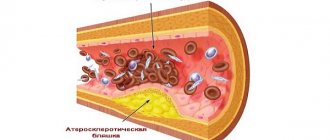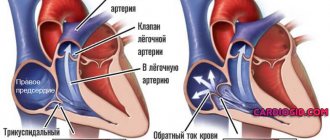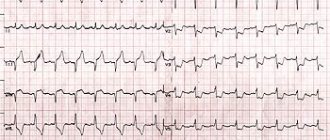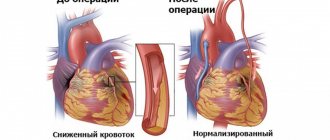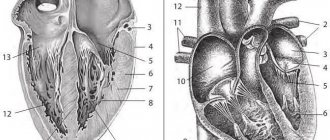30% of all deaths in Russia occur due to alcohol abuse. Ethyl alcohol changes the physiology of the entire body, but its effect on blood vessels and the heart is especially severe. Remember the main thing: there really are no “safe” doses. There are only dosages that are relatively tolerable for the heart muscle, but the slightest excess beyond this threshold can be fatal at any time.
Content:
- How alcohol affects the heart
- What happens to the heart when taking high doses of alcohol?
- Screening for people with heart problems caused by alcohol
- Heart treatment for alcoholism
There is no need to believe that alcohol has a positive effect on the functioning of the cardiovascular system.
Talk about the need to drink a certain amount of vodka or good red wine every day is a banal myth. Most often they are invented by people who want to drink but have serious illnesses. Alcohol and the heart are incompatible concepts. As a result of drinking, nervous tissue is invariably damaged.
Following this, ethanol attacks the heart muscle. Then the addict develops alcoholic cardiomyopathy. If left untreated, it can be fatal. Is it possible, knowing about such consequences, to talk about benefits?
Diagnostics and additional research methods
The diagnosis of alcoholic cardiomyopathy is based on:
- inspection data;
- survey;
- listening to the heart.
A patient with suspected AK should definitely undergo electrocardiography. Characteristic changes clearly appear in the recording. Heart ultrasound provides a large amount of information.
The necessary examination is radiography (or Rg-scopy). The radiologist notes a specific syndrome - myopathic configuration. A characteristic feature of this syndrome is an increase in cardiac dimensions during the period of binge drinking and a decrease during the period of calm (remission). In the “language” of radiologists, this feature received the figurative name of the “sliding harmonic” symptom.
Histological analysis of the myocardium determines the presence of fatty impregnation of muscle tissue, accumulation of glycogen and swelling of cardiocyte elements. From a prognostic point of view, alcoholic cardiomyopathy can undergo reverse development if the patient maintains a sober lifestyle.
How alcohol affects the heart
Drinking alcohol in high doses causes the development of myocardial dystrophy. This is a pathology in which metabolic processes in the heart muscle are disrupted. As a result of the disease, the load on the organ increases significantly, and it ceases to cope with it.
There are two main causes of myocardial dystrophy. This:
- a rapid decrease in the production of cardiocytes - substances that provide heart cells with energy;
- decrease in thiamine levels.
Both factors are associated with drinking. The difficulty is that it is almost impossible to recognize the development of disorders in the early stages, when life-threatening complications can still be avoided. The alcoholic feels good for a long time. When he gets to a specialized clinic, it turns out that his heart is working at the limit of its capabilities.
Progressive myocardial dystrophy leads to:
- hypertension, hypertensive crisis;
- angina pectoris;
- pain in the chest area;
- poor quality myocardial nutrition;
- ischemic disease.
The effect of alcohol on the heart is so harmful that the organ cannot function fully. This is why alcoholics often die due to stroke, hypertensive crisis, or heart attack.
Cardiovascular health: how to take care of it
The heart has no days off or holidays. The organ works smoothly in any circumstances, and always needs all possible support. Regardless of whether there are obvious heart problems or they are not yet felt, you need to take care of the main engine constantly.
Give up alcohol and cigarettes forever. The most destructive effect of alcohol on the heart and blood vessels occurs as a result of a combination of these two bad habits. Nicotine excessively constricts blood vessels, creating oxygen starvation; alcohol, on the contrary, dilates blood arteries, making them fragile. If an alcoholic smokes more than 3 cigarettes a day, the likelihood of a stroke or heart attack increases 3 times than if he simply abused alcohol. But both habits are deadly separately.
Watch your weight. Overweight people are always at risk. Fat that envelops internal organs is the most dangerous: unlike subcutaneous fat, it is almost impossible to eliminate. In such cases, myocardial dysfunction occurs much more often. Running, walking, swimming and cycling can help you lose weight, but the permissible load should only be determined by a specialist.
Review your diet:
- Replace pork and lard with beef and poultry.
- Drink no more than 1.5 liters of clean water per day so as not to cause swelling.
- Remove canned food from your diet and do not exceed the daily salt intake - 5 grams.
- Limit your coffee intake or eliminate it completely.
- Apples, dark grapes, plums, strawberries, garlic, flax seeds, grape seeds, arugula, onions, asparagus, nuts, honey and fatty fish are those foods that are good for blood vessels and the heart, which should be included in the diet regularly or as often as possible .
The harm of alcohol and its harmful effects on the heart and blood vessels is difficult to exaggerate. But there is no benefit, even conditional, from alcoholic drinks. And if a young body can somehow resist the threat, then after 40 years the consequences of drinking alcohol can cost one’s life.
What happens to the heart when taking high doses of alcohol?
As soon as the heart muscle is exposed to the negative influence of large amounts of alcohol, the following pathological changes are observed:
- the myocardium begins to contract poorly;
- heart rhythm is disturbed (usually towards tachycardia);
- blood oxygen saturation decreases (hence severe shortness of breath);
- The minute volume of blood decreases, due to which the atria and ventricles do not receive important nutrients and oxygen.
Drinking heart patients often develop edema. They suffer from an unpleasant feeling of lack of air. If you ignore all these symptoms, dangerous complications cannot be avoided in the near future.
Heart failure from alcohol
Heart failure is a widespread disease. Heart failure is a condition where, as a result of damage to the heart, the heart muscle weakens and cannot satisfactorily perform its pumping function. As a result, the body's supply of oxygen and nutrients is disrupted.
Causes of heart failure
Heart failure most often develops as a result of coronary heart disease (myocardial infarction, angina pectoris). Arterial hypertension, valvular heart disease and cardiomyopathies also lead to heart failure.
How does chronic heart failure manifest?
The most common symptoms are shortness of breath and weakness. Initially, everyday physical activity is not accompanied by weakness, shortness of breath or palpitations. Then it is somewhat limited, but at rest there are no complaints. Everyday stress may cause weakness, shortness of breath, or palpitations. Over time, as the disease progresses, complaints appear with little physical activity and at rest.
In heart failure, edema develops in the body due to water and sodium retention. They appear first in the ankle area and disappear after rest or towards the end of the day, and then may spread and do not disappear after a night's rest.
Drug therapy for heart failure
Only a doctor after examination can make a diagnosis and prescribe treatment. Different groups of drugs are used to treat heart failure. Regular and correct use of medications will help improve the health of patients. You need to know the names and dosages of the medications you are taking and strictly follow your doctor's instructions. Non-drug treatment methods are of particular importance in improving the health of patients.
Weight monitoring
Patients are advised to weigh themselves regularly (it is better to weigh themselves during some daily activities, for example, after the morning toilet), and in the event of a sudden unexplained weight gain of more than 2 kg in three days, inform the doctor or increase the dose of the diuretic.
Diet
Salt restriction (2-5 g/day) is more important in severe heart failure. Salt substitutes should be used with caution, as they may contain potassium and in large quantities, especially when taking ACE inhibitors simultaneously, cause hyperkalemia.
Liquid
In patients with severe heart failure, regardless of the presence of hyponatremia, free fluid restriction to 0.6 l/day is indicated. Vitamins A1, B1, B2, C, PP are added. Meals are fractional (for the whole day, bread 150 g, sugar 40 g, butter 10 g).
It is acceptable to drink alcohol in moderate doses (a bottle of beer or 1-2 glasses of wine per day). If alcoholic cardiomyopathy is suspected, alcohol is excluded.
In obese patients, treatment of heart failure includes weight loss. We speak of being overweight if the body mass index (BMI) = weight (kg)/height (m2) is 25-30; if it exceeds 30, obesity is diagnosed.
Pathological weight loss
Pathological weight loss is observed in approximately 50% of patients with heart failure. The decrease in fat and lean body mass that accompanies such weight loss is called cardiac cachexia. This condition is an important predictor of reduced life expectancy. Pathological weight loss should be suspected if:
- body weight is less than 90% of ideal
and/or
- there is a documented unintentional weight loss of more than 5 kg, or 75% of baseline (measured in the absence of edema) over 6 months and/or
- BMI is less than 22 kg/m2.
The goal of treatment is to achieve weight gain not through edema, but preferably through muscle mass through adequate physical activity. If weight loss is caused by nausea, shortness of breath or a feeling of fullness in the stomach, frequent small meals are recommended.
Smoking
Quitting smoking is desirable in all cases. The use of auxiliary products, in particular nicotine patches, chewing gum, etc., should be strongly encouraged.
Staying in high mountains, places with a hot or humid climate is contraindicated. Short flights are preferable to long trips by other means of transport. In case of severe heart failure, long flights are fraught with complications (possible dehydration, sudden swelling of the legs, deep vein thrombosis), which patients should be warned about. Possible consequences of changes in diet during travel in the form of acute gastroenteritis. If water and salt are lost in hot and humid climates, the dose of diuretics and vasodilators must be adjusted accordingly.
Sex life
It is impossible to give unambiguous recommendations on sex life. If necessary, it is recommended to take nitrates under the tongue before sexual intercourse and abstain from particularly violent emotions. In functional class II, the risk of decompensation provoked by sexual activity is average, and in functional class III-IV it is high. Little is known about the effect of heart failure treatment on sexual function.
Immunization
There are no reliable data on the effects of immunization in heart failure. Immunization against pneumococcal disease and influenza reduces the risk of respiratory infections that can worsen heart failure. Immunization against influenza is widely used.
In case of acute heart failure or destabilization of chronic heart failure, rest is necessary, including bed rest. To prevent the undesirable consequences of bed rest, including venous thrombosis, passive exercises are performed. As the condition improves, they move on to breathing exercises and gradually increase activity.
Exercise stress
If the patient's condition is stable, then moderate physical activity, which prevents muscle detraining, should be encouraged. For patients with severe functional impairments, short training sessions (15-20 minutes) 3-5 times a week are recommended. The intensity of training is selected so that the heart rate reaches 60-80% of a predetermined maximum value. Preference is given to walking at an average pace (60-80 steps per minute).
The doctor must talk with the patient so that the patient can actively participate in treatment. The patient must know and understand:
- improvement may be slow and incomplete even after weeks, and with some drugs, months of treatment;
- doses of ACE inhibitors, angiotensin receptor blockers and beta-blockers should be gradually increased to a certain level, although this will not bring direct improvement;
- in case of dehydration (at rest, with profuse sweating in hot climates), the dose of diuretics should be reduced;
- when blood pressure decreases, it is necessary to reduce the dose of diuretics, and, if necessary, ACE inhibitors, angiotensin receptor blockers and beta-blockers;
- ACE inhibitors may cause cough and taste disturbances;
- Non-steroidal anti-inflammatory drugs should not be taken simultaneously with ACE inhibitors;
- if shortness of breath suddenly appears or as a preventive measure in certain situations, you can take nitrates - in the form of tablets under the tongue or an aerosol.
Treatment of heart failure has several goals. First, eliminating the symptoms characteristic of this disease. Secondly, and no less important, is to protect organs from damage: heart, kidneys, lungs, brain, liver, blood vessels. The third goal is to improve the patient's quality of life. This means that treatment for heart failure should provide the patient with the opportunity to live the same full life as his healthy peers.
Screening for people with heart problems caused by alcohol
Patients who have cardiovascular diseases or are prone to developing them and who drink alcohol frequently and in large quantities should definitely be examined.
It is good if diagnostic procedures are suitable at the stage of preparation for coding in a narcology clinic. Then the doctor will be able to tell which option of anti-alcohol therapy is most appropriate, and the cardiologist will prescribe an effective treatment program for the identified cardiac disorders. When identifying alcoholic cardiomyopathy, the following diagnostic measures are used:
- Examination and interview of the addict. The doctor finds out how long ago and what kind of alcoholic compounds the patient has been taking, whether he was previously coded, and whether he underwent therapy for cardiac pathology.
- Study of percussion and auscultation patterns. The specialist listens to heart sounds and taps the chest area. Particular attention is paid to noise and rhythm.
- Carrying out ECG and ultrasound. These diagnostic methods are highly accurate, safe and effective. Based on their results, the cardiologist can easily make the correct diagnosis.
It is very important that a person undergoing diagnosis and planning treatment for heart disease observe the law of sobriety. It is unacceptable to go to doctors during the day and get drunk in the evening.
How to avoid becoming an alcoholic?
If you do not have signs of alcoholism, but you drink alcohol often and in large quantities, decide to reduce the amount of alcohol and reasons for drinking. Do not let the situation get out of control if you value your family, work, and your health.
- Avoid companies where large amounts of alcohol are consumed.
- Control the amount of alcohol you drink.
- Do not hesitate to refuse if you are offered a drink.
- Learn to relax in other (non-alcoholic) ways: engage in sports, creativity, tourism or other enjoyable activities.
If you or someone close to you has signs of alcoholism, consult a doctor immediately!
It is very difficult to cope with the disease without the help of a doctor. Remember: to cope with this serious illness, modern treatment methods and the active desire of the patient himself to get rid of the disease are necessary!
Heart treatment for alcoholism
To support the functioning of the main organ, alcoholic patients with heart disease are prescribed medications for:
- pain relief;
- reducing the voltage level;
- elimination of degenerative and dystrophic processes in the myocardium;
- normalization of heart rate;
- strengthening the whole body, stimulating the immune system.
It is very important to improve your heart function during the pre-coding phase. But even after coding, cardiotherapy does not stop. The patient consults a cardiologist for as long as necessary.
Take care of your heart - don't drink alcohol. On holidays, if necessary, use only high-quality alcohol and in small quantities. Any drinking is a blow to your heart. It is impossible to predict in advance how strong it will be. It's important to remember this.
Need some advice?
OR CALL A DOCTOR
CALL!
+7
How does alcoholism develop?
There are three stages of alcoholism.
The first is the stage of mental dependence.
At this stage, it becomes habitual for a person to drink alcohol in order to forget about troubles and adversities, facilitate contact with others, and relax. A person is constantly looking for a reason, appropriate company, to drink. Control over the amount of alcohol consumed is lost: once a person starts drinking, he cannot stop and reaches a state of severe intoxication. In addition, at this stage, a person’s threshold of sensitivity to alcohol decreases, that is, in order to achieve the desired level of intoxication, he needs a dose 2-3 times larger than before. The gag reflex, which is the body’s defense mechanism during alcohol poisoning, disappears. When a person gets drunk, he loses control of himself, often commits reckless acts, and later cannot remember what happened to him the day before. After alcohol abuse, sleep deteriorates, after drinking, the mood deteriorates, sweating, palpitations, and sometimes hand trembling are noted.
The second is the stage of physical dependence.
Regular alcohol abuse leads to changes in the biochemical processes of the body, as a result of which the regular intake of alcohol into the body becomes necessary for its normal functioning. At this stage, signs of an alcoholic hangover appear and become established. A person, being in a state of hangover, experiences many unpleasant sensations - headache, nausea, sweating, palpitations, anxiety, trembling fingers. In order to alleviate the condition, a person drinks alcohol again - gets a hangover.
From the moment a hangover appears, a person is terminally ill. The only measure that can help stop the disease is a complete abstinence from drinking alcohol in any form.
This can be repeated for several days - 3 days or more. Binges occur. In the absence of alcohol entering the body, a person experiences mental disorders, headache, thirst, loss of appetite, muscle tremors, irritability, and aggression.
The third is the stage of personality degradation.
A person becomes indifferent to family and friends, neglects the most basic rules of morality and ethics, and is indifferent to his behavior. His memory is deteriorating and his intelligence is decreasing. At this stage, people begin to drink “whatever”, as long as the liquid contains alcohol. Drunkenness is constant (daily) in nature or is expressed in binges that stop due to a sharp deterioration in physical condition and often require medical care, without which a person can die. At this stage, the changes that have occurred in the internal organs are irreversible. Alcohol completely destroyed their normal functions.
Consequences of ignoring the problem
Hangover syndrome does not tolerate neglect. As soon as alcohol enters the body, the heart increases in size, and as a result, the person’s weight increases. Heart pain may increase each time you drink alcohol. In a normal state, a person will not feel discomfort, but as soon as he drinks alcohol, the pain in the heart intensifies.
A hangover is the first call to quit drinking. Otherwise, the patient experiences deformation , various disorders arise, irritability prone to aggression, paranoia, epilepsy, volitional character traits are deformed, and much more.
An hour-long feast with drinking alcoholic beverages is not worth ruining human life. Think about it!
If you cannot cope with a hangover, then call a narcologist to your home! An experienced doctor will quickly help you get rid of all symptoms.
Our phone numbers:
What is alcohol?
Alcohol is a depressant, that is, a substance that slows down all processes in the body. Small doses of alcohol give a feeling of relaxation and self-confidence. In large doses, it slows down the reaction and negatively affects, for example, the eye and coordination. Driving while not sober is extremely dangerous. A person in a state of severe intoxication experiences nausea, dizziness, and may lose consciousness, then on top of everything else there is the danger of choking on his own vomit.
The degree of intoxication may depend in part on the strength of the drink, that is, on the concentration of alcohol in it. The strongest drinks are whiskey, vodka, followed by various wines, and finally, BEER. In addition, the size of the drinker matters. In general, larger people are more resistant to the effects of alcohol than smaller people.
Alcohol abuse can lead to obesity, because alcohol contains calories, although it is not nutritious at all, to ulcers, cirrhosis of the liver, as well as to diseases of the brain, kidneys and muscles, including the heart.
The brain of a person who regularly drinks alcohol in large doses constantly struggles with its depressive effects. If such a person stops drinking, his brain, by inertia, continues its compensatory activity, which is why he becomes excited, nervous, fussy, his hands tremble, and this continues until he drinks more. Here is a typical example of alcohol addiction.
Scientific studies and statistics show that people who drink alcohol in light or moderate doses have lower premature mortality than non-drinkers and heavy drinkers. Various theories have been put forward to explain this phenomenon: some believe that alcohol causes the body to produce substances known as high-density lipoproteins, which prevent cholesterol from depositing in the arteries. Others believe that the heart is protected by substances found in certain varieties of red wines that inhibit oxidative processes. The well-known relaxing effect of alcohol also helps with stress.
It would be bad if these facts prompted someone to take a drink for the first time or increase their alcohol consumption. Drinking destroys the brain, liver, digestive tract and stomach. Liver cirrhosis and pancreatic cancer are diseases of drinkers. Obesity and hypertension, as well as heart disease, are the result of heavy drinking.
The level of alcohol concentration in the blood depends on a number of factors.
- If you eat fatty foods, then intoxication will not be as quick.
- The high content of animal and vegetable fats slows down the absorption of alcohol and the digestion of the food itself.
- The fuller the stomach, the longer it will take for alcohol to reach the circulatory system.
- The thicker your body fat, the slower alcohol is digested and absorbed into the blood.
- Body weight: the heavier you are, the lesser the effects of alcohol on you.
- Your reaction to drinking 80 mg of alcohol may be completely different than someone else's. Typically, young people and women are more susceptible to alcohol.
The ability to consume alcohol and the effect it has on different people varies; however, it is believed that a safe dose (from a health point of view) is somewhere around 5 liters of BEER of medium strength or 10 large glasses of wine per week for men and 2/ 3 of this dose for women, provided, of course, that this amount will be lost evenly over the course of a week, and not in 1-2 times. If you can, try not to drink on an empty stomach.
One of the surest ways to avoid a hangover is to not drink on an empty stomach. Some argue that drinking a glass of milk before drinking alcohol slows down its absorption in the body. Following this advice, drink in moderation and dilute alcoholic drinks.
Alcoholism – what is it?
Alcoholism is the regular, compulsive consumption of large amounts of alcohol over a long period of time. It is the most serious form of drug addiction in modern times, affecting between 1 and 5% of the population in most countries. An alcoholic drinks compulsively in response to a psychological or physical dependence on alcohol.
Anyone can become an alcoholic. However, studies have shown that for children of alcoholics, the risk of becoming alcohol dependent is 4-6 times higher than for children of non-alcoholics.
The study of alcohol consumption among young people in Russia is largely based on the experience of similar studies abroad, which in the late 19th and early 20th centuries were widely carried out in Western Europe and North America and were conducted in a variety of directions:
- The prevalence and patterns of alcohol consumption among students were studied.
- The effect of alcohol on children's and adolescents' bodies was studied.
- The relationship between academic performance and alcohol consumption was determined.
- Anti-alcohol education programs were developed and tested.
A significant place among the studies of this period was occupied by works illustrating the prevalence and nature of drinking customs, when children were given alcoholic beverages for:
- “health promotion”
- "appetite"
- “improved growth”
- “to relieve teething”
- “warming up”
- “satisfy hunger”
- "calm"
The strong belief in the strengthening effect of alcohol that existed in the 19th and at the turn of the 20th centuries often resulted in the direct alcoholization of the child.
It is estimated that two thirds of alcoholics are men. Case studies of alcoholism show that alcoholism is often part of the overall picture of depressive illness. Many alcoholics suffer from childhood emotional problems, often related to the loss, absence, or inadequacy of one or both parents.
Six stages of alcoholism
Casual drunkenness can lead to alcoholism: because the drinker begins to turn to alcohol to relieve stress, or because it is so strong that the initial stages of addiction remain unnoticed.
Early alcoholism is marked by the appearance of memory lapses. Alcoholization of the younger generation is considered by most researchers as a significant indicator of the dysfunction of the microsocial environment. This determines the constant interest in studying the problem of the prevalence and nature of early alcoholism.
Early alcoholism includes exposure to intoxicating doses of alcohol before the age of 16. Early (teenage) alcoholism should be discussed when its first signs appear before the age of 18. When analyzing the alcoholism of minors, we proceeded from the methodologically important proposition that the use of alcoholic beverages by adolescents must be considered as a form of behavioral disorder. This requires a broader and deeper approach to the problem under consideration, not limited to the framework of social and clinical narcology.
Boys drink the main types of alcoholic beverages more often than girls, and as their strength increases, this difference becomes significant. Among urban schoolchildren, it is common to consume predominantly weak alcoholic drinks - beer, wine, while students in rural schools are more familiar with the tastes of strong alcoholic drinks. In the 1920s and 1920s, one could find fairly widespread use of moonshine by schoolchildren: 1.0–32.0% among boys and 0.9–12% among girls. The frequency of vodka consumption increased with age.
Almost all socio-hygienic and clinical-social studies of youth alcoholism used the survey method in various modifications - from correspondence questionnaires to telephone interviews and clinical interviews.
It is most difficult to compare data on the prevalence and frequency of alcohol consumption among young people, since authors not only from different countries, but even from the same country in the same historical period used qualitatively different methods for identifying users and non-users. alcohol, different age classifications, etc.
Despite the diversity of criteria for identifying alcohol abusers and alcoholics in adolescence, data from various authors still allows us to judge that their number is quite large. Analysis of the materials shows that over the past 100 years, regardless of the level of consumption and abuse of alcoholic beverages, the prevalence of alcoholism itself among young people remains at a fairly stable level, not exceeding 5% of patients under 20 years of age and 8-10% of patients under 25 years of age. This fact is of fundamental importance, as it indicates the dynamics of the emergence and development of early forms of alcoholism in the holistic structure of alcohol morbidity. Drinking on the sly and an urgent need for the first drink indicate a growing addiction. The drinker feels guilty, but cannot discuss his problem with others.
Basic alcoholism - the drinker cannot stop until he reaches the stage of poisoning. He encourages himself with self-justifications and pompous promises, but all his promises and intentions remain unfulfilled. He begins to avoid family and friends and neglect food, past interests, work and money. Physical deterioration of health occurs. Resistance to alcohol decreases.
Chronic alcoholism is characterized by further moral decline, irrational thinking, vague fears, fantasies and psychopathic behavior. Physical damage is mounting. The drinker no longer has an alibi, and he can no longer take steps to get out of the current situation. A person can reach this stage in 5-25 years.
Treatment is usually carried out through special programs for alcoholics. Psychologically, the desire to get help is revived in the alcoholic, and he begins to think more rationally. Ideally, he also develops hope, moral responsibility, external interests, self-esteem, and satisfaction with abstinence from alcohol.
The final stage of alcoholism occurs if the alcoholic refuses treatment or breaks down again after treatment. Irreversible mental and physical damage usually ends in death.
If you write all this briefly, this is what you get:
- Domestic drunkenness
- Early alcoholism
- Basic alcoholism
- Chronic alcoholism
- Cure
- The final stage of alcoholism
What determines the degree of intoxication of a person?
The effect of alcohol on behavior depends on the amount of alcohol that reaches the brain through the blood. This “blood alcohol level” is determined by several other factors besides how much you drink.
The size of the liver determines the rate of oxidation and elimination of alcohol.
The weight of the person himself determines the amount of blood in the body, since the volume of blood is proportional to it. The larger the person, the more the blood is diluted by the alcohol consumed and the more it is needed to have the same effect.
The speed and manner of alcohol consumption are also important. The slower a person drinks a certain amount of alcohol, the weaker its effects.
Drinking alcohol on an empty stomach has a stronger and faster effect than drinking it during or after a meal. Food acts as a buffer during absorption.
The process of intoxication.
When drinking alcohol, the transmission of impulses in the nervous system slows down. The highest levels of the brain are the first to be affected - inhibitions, excitement and anxiety disappear, giving way to a feeling of contentment and euphoria. As the lower levels of the brain are affected, coordination, vision and speech deteriorate. Small blood vessels in the skin dilate. Heat is radiated and the person becomes hot. This means that the blood has diverted away from the internal organs of the body, where the blood vessels have already narrowed due to the effects of alcohol on the nervous system. Therefore, the temperature of the internal organs drops at the same time. A possible increase in sexual desire is associated with the suppression of ordinary prohibitions. As blood alcohol levels rise, physical sexual performance becomes increasingly impaired. Eventually the toxic effects of alcohol cause nausea and possibly vomiting.
Hangover
A hangover is bad... And now in more detail:
A hangover is physical discomfort after consuming excessive amounts of alcohol. Symptoms may include headache, upset stomach, thirst, dizziness and irritability. A hangover occurs as a result of three processes. Firstly, the gastric mucosa is irritated by excess alcohol, and the functioning of the stomach is impaired. Secondly, cell dehydration occurs if the amount of alcohol consumed exceeds the liver's capacity, resulting in alcohol remaining in the blood for a long time. Thirdly, the level of alcohol has a “shock” effect on the nervous system, from which it takes time to recover.
The best way to avoid a hangover is not to drink too much (or better yet, not to drink at all). But the likelihood of a hangover is reduced if alcohol is mixed with a snack (Havka): the intake and absorption of alcohol is extended over a longer period of time, and food serves as a barrier. Non-alcoholic drinks taken at the same time or after will dilute the alcohol. The ill effects are also usually reduced if alcohol is consumed in a relaxed environment and smoking is kept to a minimum.
The stomach is soothed by a fresh lining: milk, raw eggs or just a good breakfast! Only then can you take aspirin or other painkillers to relieve your headache. The risk of stomach irritation from pain medications is much greater when the stomach is empty. It is known that citrus juices, honey and vitamin C contain an “anti-hangover factor”. Fizzy drinks can have a soothing effect on the stomach. Liquids of any kind will help restore the fluid content of dehydrated cells. Coffee and tea are used to clear your head (caffeine stimulates the nervous system), and sugar will provide you with energy; but both caffeine and sugar can make a person's condition worse after their immediate effects wear off. In the same way, alcohol is also taken as a temporary relief, which (in moderation) encourages a withered nervous system and seems to disperse unpleasant sensations. But this is only a reprieve: the initial hangover and the hangover from a new dose of alcohol are still waiting for you!
The effect of alcohol on the body
Blood. Alcohol inhibits the production of platelets, as well as white and red blood cells. Result: anemia, infections, bleeding
Brain . Alcohol slows down blood circulation in the vessels of the brain, leading to constant oxygen starvation of its cells, resulting in weakening of memory and slow mental degradation (or simply dullness). Early sclerotic changes develop in the vessels, and the risk of cerebral hemorrhage increases. Alcohol destroys the connections between the nerve cells of the brain, developing in them the need for alcohol and alcohol dependence. Destruction of brain cells and degeneration of the nervous system sometimes lead to pneumonia, heart and kidney failure, or organic psychosis. Delirium tremens is a condition accompanied by extreme agitation, mental insanity, restlessness, fever, trembling, fast and irregular pulse and hallucinations, which often occurs when drinking large quantities of alcohol after several days of abstinence.
Heart. Alcohol abuse causes increased blood cholesterol levels, persistent hypertension and myocardial dystrophy. Cardiovascular failure puts the patient on the brink of the grave. Alcoholic myopathy: muscle degeneration resulting from alcoholism. The reasons for this are lack of use of muscles, poor diet and alcohol damage to the nervous system. Alcoholic cardiomyopathy affects the heart muscle.
Intestines. The constant effect of alcohol on the wall of the small intestine leads to a change in the structure of cells, and they lose the ability to fully absorb nutrients and mineral components, which ends in the depletion of the alcoholic’s body.
Diseases associated with poor nutrition and vitamin deficiency , such as scurvy, pellagra and beriberi, caused by neglecting food for the sake of drinking. Persistent inflammation of the stomach and later intestines with an increased risk of ulcers.
Liver. Considering that 95% of all alcohol entering the body is neutralized in the liver, it is clear that this organ suffers the most from alcohol: an inflammatory process occurs (hepatitis), and then scarring (cirrhosis). The liver ceases to perform its function of disinfecting toxic metabolic products, producing blood proteins and other important functions, which leads to the inevitable death of the patient. Cirrhosis is an insidious disease: it slowly creeps up on a person, and then strikes, and immediately leads to death. Ten percent of chronic alcoholics have cirrhosis of the liver, and 75% of people with cirrhosis are or have been alcoholics. Until cirrhosis develops sufficiently, there are almost no symptoms, then the alcoholic begins to complain of a general deterioration in health, loss of appetite, nausea, vomiting and digestive problems. The cause of the disease is the toxic effects of alcohol.
Pancreas. Patients suffering from alcoholism are 10 times more likely to develop diabetes than non-drinkers: alcohol destroys the pancreas, the organ that produces insulin, and profoundly distorts metabolism.
Leather. A drinking person almost always looks older than his age: his skin very soon loses its elasticity and ages prematurely.
Stomach . Alcohol suppresses the production of mucin, which performs a protective function in relation to the gastric mucosa, which leads to the occurrence of peptic ulcers.
A characteristic manifestation of alcohol poisoning is repeated vomiting. Even a single consumption of small doses of alcoholic beverages is accompanied in adolescents by pronounced manifestations of intoxication, especially in the nervous system. The most severe poisonings are observed in persons with a complicated medical history, against the background of organic cerebral insufficiency or concomitant somatic pathology.
It is much less clear to describe the nature of the influence of alcohol on the psyche of a teenager. In general, the clinical picture of severe intoxication in a teenager in most cases looks like this: short-term excitement is then replaced by general depression, stupor, increasing drowsiness, lethargy, slow incoherent speech, and loss of orientation.
If we turn to subjective data, to survey data, then despite their incorrectness (usually those who have recently become acquainted with alcohol and those who have some experience of alcoholism are simultaneously interviewed; it is not always checked whether the child being interviewed correctly understood the researcher’s question and etc.) it can be stated that in subjective experiences, especially at the very beginning of acquaintance with alcohol, negative or indifferent sensations play a predominant role. Of the 605 schoolchildren aged 6-16 years surveyed, while drinking alcohol, 41.1% had unpleasant and severe somatopsychic sensations, 35.6% had an indifferent state, 23% had a pleasant state, and 61.2% had a headache after drinking. %, nausea – in 8.4%, vomiting – in 14.8%, depressed state in 3.6%, weakness in 12.4% of respondents. When asked about how they felt when they were drunk, the following answers were received from schoolchildren:
- mood lifting – 47.8%
- indifferent state – 18.4%
- low mood – 6.1%
- physical illness – 27.6%
When drinking alcohol for the first time, 53% of teenagers felt disgust. Over time, with an increase in the “experience” of drinking alcohol, the objective picture, however, changes dramatically. More than 90% of the adolescents surveyed with two years or more “experience” of drinking believed that intoxication is accompanied by a feeling of a surge of energy, a feeling of contentment, comfort, and an increase in mood, that is, those attributes of a mental state that ordinary consciousness often attributes to the action begin to appear in their statements. alcohol.
Diseases or simply PSYCHOSIS
Delirium tremens usually occurs against the background of a hangover, with a sudden cessation of drinking or during a period of abstinence, in cases of the addition of somatic diseases, injuries (especially fractures). The initial symptoms of psychosis are worsening night sleep, the appearance of vegetative symptoms and tremors, as well as the general liveliness of the patient, noted in his movements, speech, facial expressions and especially mood. Over a short period of time, one can notice a variety of shades of mood, while during the period of a hangover the mood is monotonous, characterized by depression and anxiety. Unusual changes in mood and general liveliness intensify in the evening and at night, while during the day these disorders decrease sharply and may even disappear completely, which allows the patient to carry out his professional duties. As the symptoms of psychosis increase, complete insomnia appears, against which visual illusions first arise, and then various hallucinations and delusions.
Delirium tremens is characterized by a predominance of true visual hallucinations. They are characterized by a multiplicity of images and mobility. Most often these are insects (bugs, cockroaches, beetles, flies) and small animals (cats, rats, mice). Less often, patients see large animals and people, in some cases having a fantastic appearance. Visions of snakes, devils, as well as deceased relatives, the so-called wandering dead, are very typical. In some cases, visual illusions and hallucinations are single, in others they are multiple and scene-like, i.e. the patient sees complex pictures. Often there are auditory, tactile, olfactory hallucinations, sensations of disturbance of the body position in space. The mood of patients is extremely changeable. In it, within a short time, one can note fear, complacency, bewilderment, surprise, and despair. Patients usually move continuously, their facial expressions are expressive. Motor reactions correspond to the prevailing hallucinations and affect at the moment - with fear and frightening visions, the patient hides, defends himself, is excited; during periods of complacency - passive.
Patients are characterized by extreme distractibility to external events; everything around them attracts their attention. Delirium in alcoholic delirium is fragmentary and reflects hallucinatory disorders. In terms of content, this is most often delirium of persecution. Patients are usually falsely oriented in place (while in the hospital, they say that they are at home, in a restaurant, at work), but are oriented in their own personality. Alcoholic delirium is characterized by periodic temporary disappearance of a significant part of mental disorders, the so-called lucid - light - intervals, as well as a naturally pronounced increase in symptoms of psychosis in the evening and at night.
Delirium tremens is constantly accompanied by a variety of somatic disorders - trembling, sudden sweating, hyperemia of the skin, especially the face. The temperature is most often low-grade. The pulse is increased. Protein often appears in the urine; in the blood - increased bilirubin content, a shift in the leukocyte formula to the left, acceleration of ROE. The course of the disease is usually short-term. Even without treatment, symptoms of psychosis disappear within 3–5 days. Less commonly, the disease drags on for 1–1.5 weeks. Recovery is more often observed in the form of a crisis - after deep sleep. Sometimes recovery is gradual, worsening in the evening and at night and improving during the day. Signs indicating an unfavorable prognosis for delirium tremens are the development of symptoms of occupational and delirium delirium, high fever, and collapsed states.
Alcoholic hallucination develops either during a hangover or at the height of binge drinking. The main disorder is abundant auditory hallucinations combined with delusions of persecution. Verbal auditory hallucinations predominate, and the patient usually hears words “uttered” by a large number of people - a “chorus of voices,” as patients often define it. Most often, the “voices” talk among themselves about the patient, less often they are addressed to the patient himself. The content of verbal hallucinations is threats, accusing discussions of the patient’s past actions, cynical abuse, insults. Often hallucinations are mocking and teasing in nature. The voices either intensify to a scream or weaken to a whisper. Delusional ideas in content are closely related to auditory hallucinations - the so-called. hallucinatory delusion. They are fragmentary and unsystematic. The predominant affect is intense anxiety and fear. At the beginning of psychosis, patients are motorically excited, but soon some retardation appears or very orderly behavior is observed, masking the psychosis. The latter creates a false and dangerous idea of improvement. As a rule, symptoms of psychosis intensify in the evening and at night. Somatic disorders, usual for hangover syndrome, are constant. The duration of alcoholic hallucinosis is from 2-3 days to several weeks; in rare cases, the disease drags on for up to several months.
Alcohol depression always appears against the background of a hangover syndrome. Characterized by a depressed-anxious mood, ideas of self-deprecation, tearfulness, as well as individual ideas of relationship and persecution. Duration – from several days to 1–2 weeks. It is in a state of alcoholic depression that alcoholics most often commit suicide.
Alcoholic epilepsy is symptomatic and associated with toxicosis. Seizures most often occur at the height of intoxication during a hangover or during alcoholic delirium. As a rule, epileptiform seizures are observed. Minor seizures, twilight stupefactions, and auras do not occur in alcoholic epilepsy. With the cessation of alcohol abuse, seizures disappear.
Alcoholic paranoid is an alcoholic psychosis, the main symptom of which is delusion. Occurs in a state of hangover syndrome and at the height of binge drinking. The content of delusional ideas is limited to persecution or jealousy (ideas of adultery). In the first case, patients believe that there is a group of people who want to rob or kill them. They see confirmation of their thoughts in the gestures, actions and words of others. Characterized by confusion, intense anxiety, often giving way to fear. The actions of patients are impulsive - they jump off vehicles while moving, suddenly run away, turn to government authorities for help, and sometimes attack imaginary enemies. In some cases, delirium is accompanied by mild verbal illusions and hallucinations, and individual delirious symptoms that occur in the evening and at night. The course of this form of paranoid is usually short-term - from several days to several weeks. Occasionally, psychosis lasts for months.
Alcoholic encephalopathies are alcoholic psychoses that develop in connection with metabolic disorders, primarily of vitamins B and PP. Alcoholic encephalopathy occurs as a result of many years of alcoholism, accompanied by chronic gastritis or enteritis and, as a consequence of the latter, impaired absorption in the intestine. Alcoholic encephalopathies develop mainly in those individuals who drink a lot but eat very little. Most often, alcoholic encephalopathies occur in the spring and early summer months. They are conventionally divided into acute and chronic. There are no sharp transitions between them. The most common form of acute alcoholic encephalopathy is Gaye-Wernicke encephalopathy. The onset is most often gradual, lasting 2–3 months, rarely longer. Increasing asthenia appears, in which weakness and exhaustion, combined with memory disorders, predominate. Appetite decreases and then completely disappears, night sleep is disrupted, diarrhea and vomiting, headaches and dizziness, loss of balance, and polyneuritis develop somewhat less frequently. Subsequently, the full picture of the disease develops. Emerging psychoses most often represent erased and undeveloped delirious pictures, less often – anxiety-delusional states. A few days later - two to three weeks after the onset of psychotic disorders - the mental state begins to be determined by either symptoms of apathetic stupor or stupor, turning into a coma. Without treatment, the disease most often ends in death. Neurological disorders are constant and great. Autonomic symptoms usually include heart rhythm disturbances, fever of central origin, breathing problems, and sphincter weakness. You can constantly observe an increase in muscle tone. Sharply increased sensitivity to pain, e.g. for injections. Various hyperkinesis are common. The appearance of paralysis of the extraocular muscles, photophobia, and nystagmus usually indicates the highest phase of the disease. It is always possible to identify polyneuritis phenomena varying in intensity and localization. The general physical condition of patients is characterized by progressive weight loss up to severe cachexia. The skin is pale or dark brown in color.
Chronic forms of alcoholic encephalopathy include Korsakoff psychosis and alcoholic pseudoparalysis. In some cases, they develop gradually, over a number of months, and then the nature of the onset corresponds to Gaye-Vorik encephalopathy, in others - acutely, after alcoholic psychoses, usually after delirium tremens.
Korsakov psychosis is manifested by memory impairments: the patient does not remember anything from current events or remembers little; Retrograde amnesia and false memories are noted - confabulations regarding everyday events. The latter can be expressed to varying degrees, sometimes absent. Patients are lethargic, passive, and show no interest in their surroundings. Speech and motor reactions are impoverished. Of the neurological disorders, the most common phenomena are polyneuritis of varying intensity. The disease lasts for months, sometimes years. Improvements are possible when you stop drinking. Alcoholic pseudoparalysis is characterized by dementia with pronounced changes in memory, loss of acquired knowledge and skills, profound impairments in judgment, and loss of awareness of the disease and criticism. The background of the mood is determined by carelessness and, in some cases, ideas of greatness. Sometimes memory disorders predominate in combination with confabulations. The course is similar to Korsakov psychosis.
Treatment of alcoholic psychoses. Patients with alcoholic psychosis must be urgently admitted to a special hospital. Some patients with hangover syndrome are also subject to hospitalization in cases where mental disorders, especially mood changes, are intense. Treatment of alcoholic psychosis in the hospital should be comprehensive - the use of multivitamins (B1, C, PP), cardiac and hypnotics with hypoglycemic and comatose doses of insulin or psychotronic (aminazine, haloperidol) drugs. The only effective treatment for alcoholic, especially acute, encephalonitis is therapy with large doses of vitamins: B1 - up to 600 mg, C - up to 1000 mg, PP - up to 300-400 mg per day for 2-4 weeks.
Alcohol poisoning.
People who abuse alcohol sometimes fall into a state of stupor, leading to coma. In extremely severe cases, breathing may stop.
However, do not assume that a person who appears intoxicated has necessarily consumed alcohol. Similar symptoms are observed in other conditions (head injuries, stroke and diabetes, as well as overdose of certain drugs).
First aid.
If the victim is unconscious but still breathing, remove anything obstructing breathing (pieces of snacks, breakfast) from the mouth and pharynx with your finger, do not try to induce vomiting. Place the victim in the resuscitation position, free the neck and waist from tight clothing, and ensure that the airway remains patent.
If the victim does not regain consciousness, call an ambulance.
Conclusion
Alcoholism is a serious disease that in some cases develops over many years. So it’s better not to drink a lot and often! And if you drink, then drink BEER!!! :)
Dentist Lisitsina E.E.



